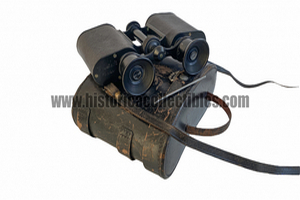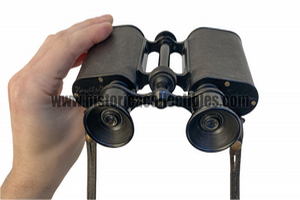Pentaprisma Binoculars 7x, Moritz Hensoldt & Söhne, Wetzlar, about 1900
Pentaprism 7x binoculars manufactured by Moritz Hensoldt & Söhne, Wetzlar, about 1900.
Made with the aluminum body covered in leather and other parts in painted brass, the binoculars are equipped with objective lenses of 22,5 mm and 7 magnifications.
On the left ocular plate there is, finely hand-engraved "Hensoldt and Söhne - Wetzlar", a type of trademark that was in use since 1896, date of entry into the company of the two sons, Waldemar and Carl, and 1899 last known date where the hand-engraved marks are found on two monoculars and part of a pentaprismatic binocular. On the right ocular plate, also finely engraved by hand, the information relating to the model: "Pentraprism Binocle".
The binoculars were made by adopting the "PENTAPRISM", that is an optical prism with five faces, of which four are affected by the path of light: two are respectively used as input and output surfaces, two operate as reflection planes; the latter are made reflective, since the angle of incidence that is too small (less than the critical angle) prevents the exploitation of the total reflection property.
Unlike the simple reflection prism, the pentaprism produces a straight image both horizontally (not inverted right-left) and vertically. The authorship of this invention, which saw its application only on very few specimens produced by Hensoldt between 1897 and 1903, can be traced back to its creators: Ernst Abbe and Albert König.
The binoculars are in excellent condition and appear to have just left the production factory. All the mechanisms work perfectly. There is also its original key to fix the chosen interpupillary distance. The view is clear and collimated.
Moritz Carl Hensoldt (November 11, 1821 in Lindenau, Thuringia; October 10, 1903 in Wetzlar) was a German entrepreneur and is considered a pioneer of optics. He was a co-founder of Wetzlar's optical and precision mechanical industry. Moritz Hensoldt was born on November 11, 1821 in Lindenau, Thuringia (today a district of Bad Colberg-Heldburg) as the son of the later ducal official secretary Heinrich Christoph Hensoldt and his wife Karoline Margarethe née Engel, who moved with their children to Sonneberg (Thuringia) after 1829 ) were drawn.
In Saalfeld, Hensoldt was trained as a precision mechanic by the coin mechanic and engraver Andreas Wiskemann. Because of his good performance, he left the apprenticeship early with his journeyman's certificate and in the following years initially worked in Kassel for the company F.W. Breithaupt, later in Hamburg at A. & G. Repsold. There he met Carl Kellner in the spring of 1846, whose workshop was taken over by Ernst Leitz after his death in 1870. A deep friendship developed between the two very different men, which determined the next years of their lives. Having the same interests and skills, Kellner and Hensoldt tried three times to set up a joint workshop and work together in it. However, their fundamentally different nature is the reason why each of their attempts has failed.
Nevertheless, the six years of their friendship, documented in 44 surviving letters that Carl Kellner wrote to Moritz Hensoldt between 1846 and 1852, shaped both men and significantly influenced their work. This is particularly true for Hensoldt, who outlived his friend, who died early, by almost 50 years. Moritz Hensoldt met his future wife Christine Ohlenburger, a cousin of Mathilde and Carl, in the house of Carl Kellner's sister Mathilde Hinckel and married in Sonneberg in 1854. Shortly after his return from Hamburg, he founded a small workshop in Sonneberg on April 15, 1847 (later Hensoldt AG).
The official founding date of the Hensoldt company, April 1, 1852, no longer holds up to the latest findings. On October 1, 2006, WetzlarerHensoldt AG, which is part of the Zeiss Group, changed its name to Carl Zeiss Sports Optics GmbH. The close connection to their father may be one of the reasons why the couple initially stayed in the Sonneberg area. The stations there are Oberlind and Neustadt bei Coburg, where Hensoldt owned a house with a workshop. The first of the couple's nine children, seven of whom survived, were born there.
The death of his father in September 1859 and the ties that both had to the Wetzlar area were probably the reason why Moritz Hensoldt met another cousin of his wife, the mechanic and optician Louis Engelbert from Oberndorf, whom he met from his stays in Wetzlar knew, founded the company Engelbert & Hensoldt in Braunfels in 1861, which soon made a good name for itself with the construction of microscopes. At the end of 1865, both families finally moved to Wetzlar. Astronomical telescope From 1877 onwards, Hensoldt began to build instruments, especially telescopes, under his own name, but remained associated with Engelbert in business and friendship until his death in 1887.
The following years were marked by a steady rise in what was initially a purely artisanal business. Moritz Hensoldt's own design drawing of a prism binoculars with a dialytic pentaprism, 1897. Moritz Hensoldt made a name for himself in the professional world with a number of his own developments, especially in the field of binoculars and the geodetic sector.
Since 1880, the company has supplied its products on a large scale, first to the British and later to the German army. The company also made a name for itself early on in the field of telescopes, later binocles (double telescopes), for private and hunting use, astronomical telescopes and measuring devices. The business successes were also the reason for the construction of an impressive new factory building on Sophienstrasse in 1895. In 1896 his sons Waldemar and Carl became partners in the company. Moritz Hensoldt went about his work every day until the end. On October 10, 1903, at the age of almost 82, he followed his wife Christine, who had died in the spring. Inventions and new designs by Moritz Hensoldt: 1877/78: Reading microscope, an instrument that is used extensively in measuring instruments. It is used for precise circle readings (theodolites, meridian circles).
1879: Scale range finder for military use
1880: Orthoscopic eyepiece, a further development of Carl Kellner's eyepiece
1892/93: Basic rangefinder together with the Beaulieu-Hahn company in Kassel, in the construction of which Hensoldt took up an old idea in correspondence with Kellner, namely to use image-inverting prism combinations
from 1897: prism double telescopes with a five-sided pentaprism, which, with its double reflection, provides the so-called “standing image” and significantly simplifies the construction of the telescope, and also allows the use of large lenses that significantly increase the light intensity1899: small range finder, a pentagon Angle prism
from 1900: Binocular telescope with dialytic system, a combination of the so-called dialytic objective system with a pentaprism with a roof edge with the aim of shortening the beam path in the binoculars (handy size). With a possible lens diameter of 35 mm at five times magnification, the light intensity is increased intensively.
1902: Prism riflescope for rifles: The newly designed roof prisms used here for the first time enabled a straight axis beam without parallel displacement.
Note: Around 1900, the Hensoldt company alone was able to mass-produce prisms with roof edges. The sensitivity of the roof edge, which manifests itself in double contours after a deviation of just a few seconds, made it necessary to create our own testing instruments. The special prism construction of the riflescope was later successfully used in the prism telescope, the Hensoldt Dialyt, developed in 1906 by Hensoldt's youngest son Carl.



